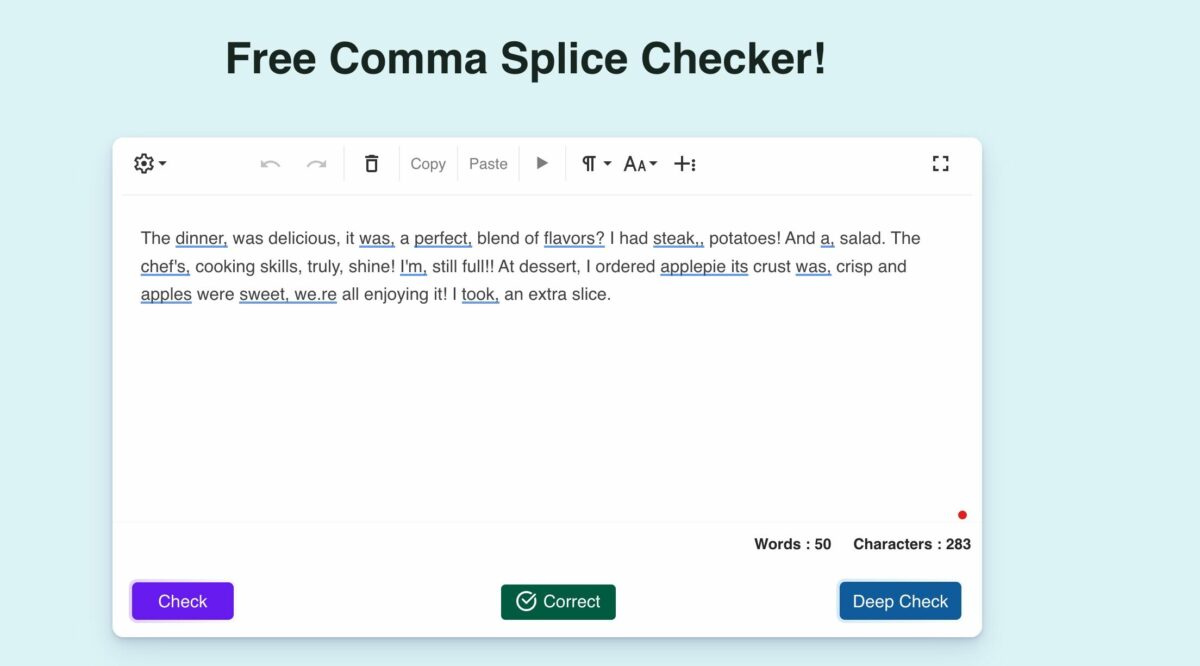Free Comma Splice Checker!

If you want to write like a pro, innocent mistakes like comma splices are unacceptable. The problem with comma splices is that they are a bit tricky. You might add one to your content without realizing it. Micromanaging your writing process might make you lose sight of the bigger picture.
It is for this reason that we recommend that you use this free comma splice checker.

How to Use the Editor?
All you need to do to use it would be to paste your content in the given window and run the checking program.
Subsequently, you will see a list of errors that you might have made.
You can rectify any comma splices that you have accidentally put in.
Comma Splice Examples
Avoiding comma splices is only possible once you know what this error punctuation entails. Here is an example of a sentence that makes use of a comma splice:
“I called home, my mother didn’t pick up,”
This is an instance where a comma is being used to separate two independent clauses.
Any phrase or sentence that is not dependent on another clause to be understood is an independent clause. Using a comma to separate these two clauses would be unprofessional.
Not to mention inappropriate grammar. The correct way to type out such a sentence would put a period point or a full stop between the two clauses.
This would end up turning them into their unique sentences. We are now going to discuss tips that you can use to avoid using comma splices in the first place.
Tips for Avoiding Comma Splices
The reason for so many writers using comma splices is that this is how sentences often sound in informal, day-to-day settings.
It is important to recognize that there is a different set of rules for written language. Regardless of how natural it may seem from a speaking perspective. Following these rules can help you maintain a concise and effective writing style
We have already discussed opting for a period point instead of a comma in that instance. But there are several other techniques that you can use to expand your repertoire.
You should develop a broader tool kit from which you can draw ideas for sentence structure. Firstly, you can swap the full stop out for a semicolon.
Although most experienced writers would be wary of using this highly enigmatic form of punctuation.
An alternative technique that you can use is to make these otherwise independent clauses dependent on one another. One way in which you can do this is by adding conjunction that can provide a coordinating role between the two clauses.
This would create a connection between them. “And” can be a versatile choice that works well in the sentence we have provided above.
The sentence would thus become “I called home, and my mother didn’t pick up”.
“But” can also be used here. In this instance, it is actually more appropriate conjunction that turns the sentence into “I called home, but my mother didn’t pick up.”
It is important to recognize that there is no one size fits all solution. Remember that you should use comma splice alternatives as and when appropriate.
Subordination conjunction can also be used here. We will start off by using “when”. This will still make the use of a comma necessary. Although, because of the presence of the conjunction it will no longer be a comma splice.
“When I called home, my mother didn’t pick up.”
You can also avoid the use of a comma through the use of the appropriate type of subordinate conjunction. In the example, the conjunction made the first clause dependent on the second. You can avoid using a comma if that is how you wish to write.
Just be sure to use alternative conjunction to make the second dependent on the first.
“I called home when my mother didn’t pick up,” and “I called home although my mother didn’t pick up,” can both be used here based on the context. It is important to factor context into your choices about sentence structure.
Is a Comma Splice Ever Appropriate?
A comma splice would not work with most formal documents and certain types of written content. But there are quite a few situations where its usage might be somewhat acceptable.
Written prose can make use of a comma splice to convey an informal tone.
Hence, in this manner, the use of a comma splice can become a literary device.
We would recommend making sparing use of comma splices, though, if at all. It can be difficult to make them work in the context of your story.
Also, improper implementation of comma splices, even in a literary context, can make your writing seem amateurish or subpar.
It is important to be strategic with comma splices if you want to use them. And try to bear in mind that there are several alternatives that can sound as good if not even better.
One use for comma splices in a literary context would be when writing dialogue. Comma splices can help make dialogue sound more naturalistic and organic.
So in these specific instances, you can be forgiven for using them if they help you to convey your intended mood.
Grammar and Punctuation Tools You Should Check Out
It can be hard to keep an eye out for such small errors at all times, so we also recommend that you use one of these excellent tools:
- Punctuation checker: This tool is best known for helping with style issues. It has a great interface and can point out all your punctuation and grammatical errors easily. You do not need to download a Chrome browse extension or a software to down, use it as an editor.
- Grammarly: You’d be hard-pressed to find a punctuation or grammar checker that is as top-notch as Grammarly. From comma splices to excess wordiness, Grammarly is the best solution for you if you want to improve the quality of your writing.
- ProWritingAid: If you’re looking for a free-to-use tool that can be used via a WordPress plug-in, this tool might be perfect for you. This is great for blog writers who want to be able to edit content with ease.